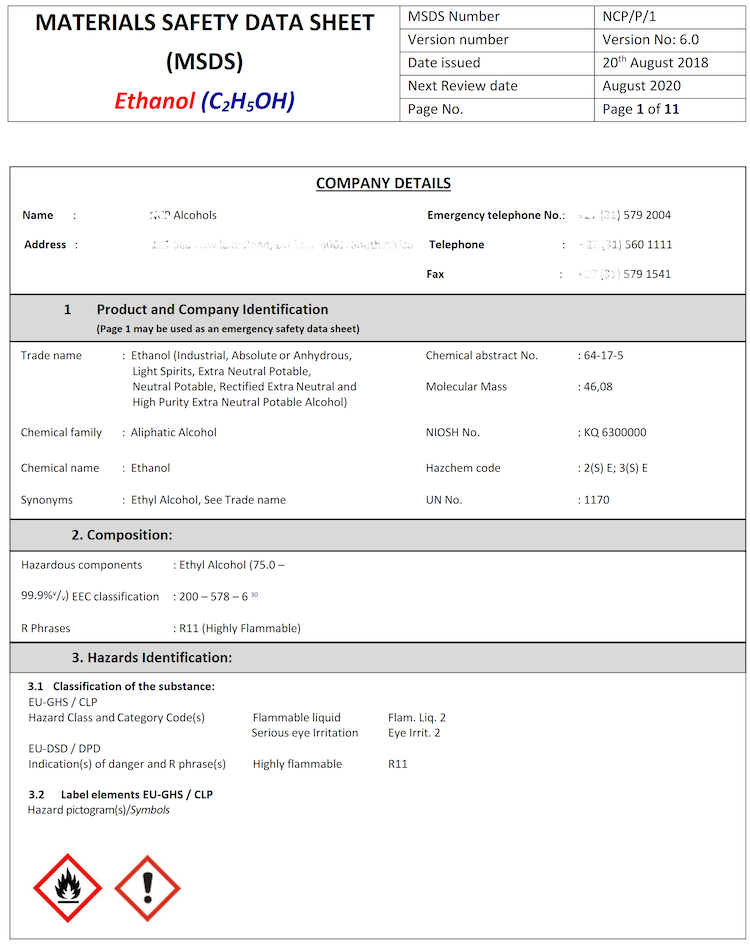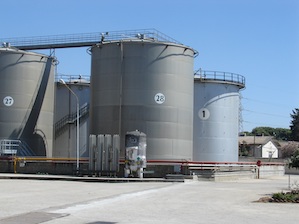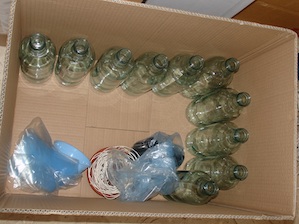| Code
| PIC-101-01
|
| General commentary
| These pictures were taken during an inspection held in Trapani (TP), Sicily, Italy. The site was a large warehouse where spirits were stored before distribution and where dehydrated absolute alcohol at 99,9% (bioethanol) is produced by a molecular sieve plant. Its storage capacity of 36.000 cubic metres is composed of 28 steel tanks directly connected by means of 2 pipelines to the port. This was a demonstration of sampling from a large static tank. In this example only one large static tank was chosen for the tax inspection.
|
| Equipment needed
|
- Dipping Vessel (L02-01)
- Bucket
- Funnel
- Sample Containers G01, M01, M02
|
| Safety precautions and risk assessment
|
See SDS.


- Pay attention to safety and warning signs.
- Wear personal protective equipment.
- You should be aware of, and follow any health and safety instructions in the local risk assessment and/or safe working practices for the location where the sampling is to take place.
- Any working activity that exposes workers to the risk of falling from a height in relation to a stable floor is considered work at height. Training must be given and adequate protective equipment supplied.
- Ladders, steps, platforms and handrails must be kept in a structurally safe condition and regularly inspected by competent personnel.
- Do not take samples during stormy weather with electrical discharges or hail.
- Before sampling the operator must earth any accumulated static charge on himself by touching some part of the structure of the tank at least 1 metre from the sampling place.
- All equipment needed for sampling should be transported appropriately. An appropriate bag or container should be used to carry the samples in order to have a hand free.
- Do not overfill the sample container and leave at least a 10 % empty space to allow for thermal expansion of the product. This must be done immediately the sample is taken.
- If the sampling requires you to enter the space at the top of a tank, at least two people equipped with appropriate personal protective equipment should be present.
- Floating roof tanks. Where possible always sample these from the gantry or access platform above the roof as toxic or flammable vapours may accumulate in the roof space. If it is necessary to go on the roof, there must be at least two people wearing appropriate respiratory protection unless it is proved that the atmosphere above the roof is safe.
- Always sample with adequate lighting.
Personal protective equipment:
|
| Sampling plan
| One aggregate sample: from three incremental samples taken at different heights of the large static tank: approximately 15 % from the bottom, half-way up and approx. 15 % from the top surface of the product in the tank. The sample is considered homogenous — if the homogeneity is in doubt, take more incremental samples. It is mandatory to measure the level of the top surface of the product by using a steel metric tape and a level paste on it, which after immersion, indicates the depth of the liquid in the container.
For determination of weight of the spirit contained in the tank, it is also important to measure the temperature of the liquid using a depth thermometer, in order to make the appropriate correction to take account of the expansion/contraction of the liquid with temperature.
Alternatively a running sample can be drawn when the product is being moved by pipe from the storage tank. Sample can be placed directly in the sample container.
|
| Links
| SAM 101 Foodstuffs, liquid, low viscosity
|
| Remark
| Tariff classification: 2207 or 2208: Undenatured ethyl alcohol (classification dependent on strength by volume)
|
| Tags
| Spirits, Ethyl alcohol, Ethanol, Alcohol, Static tank, Liquid
|
This material should only be used in connection to a proper sampling plan
|
| Order of displayed pictures | Comment |
 | PIC-101-01-A01
For the purposes of tax assessment of alcohol, it is necessary to determine the alcohol content by taking samples from storage tanks and sending these samples to the Customs Chemical Laboratory.
Product description: alcohol of agricultural origins
When arriving on an unfamiliar site make sure you understand the general situation including the full range of risks associated with any product on site regardless of the particular product you are sampling. In this case the storage facility held spirits.
|
 | PIC-101-01-A02
Preparing the sampling tools:
1 litre glass bottles with airtight cap, thread, leads and labels for sample packaging
|
 | PIC-101-01-A03
Preparing the depth thermometer – the temperature of the sampled spirit must be measured to allow calculation of total weight of the spirit in the tank
|
 | PIC-101-01-A04
The sampling point: the open access to the tank
The sampling will be carried out by the Customs officer.
Prior to opening the hatch, the pressure gauge of the tank must be checked. If necessary the release valve should be opened slowly to bring the tank to atmospheric pressure. If no release valve exists, slowly loosen hatch cover bolts to relive pressure in the tank. Stop if pressure is too high or if a release occurs.
|
 | PIC-101-01-A05
Measuring the level of the top surface of the product by using a steel metric tape and a level paste on it, which after immersion, indicates the depth of the liquid in the container
|
 | PIC-101-01-A06
The level paste on the steel metric tape after immersion which indicates the depth of the liquid in the container.
|
 | PIC-101-01-A07
The dipping vessel is lowered into the tank allowing the sample to flow into the vessel, drawing of a running sample directly in the sample container. This way reduces the possibility of air absorption, vapour loss and contamination.
Just before sampling, wash the bottle with the product to be sampled.
The incremental samples are placed in the bucket and thoroughly mixed to create the aggregate sample.
|
 | PIC-101-01-A08
The sample containers must be almost full but just less than 90% by volume of their capacity.
|

 |
PIC-101-01-A09
The sampling is complete – final samples.
The samples were checked to ensure they did not leak. The closures were secured with a polyethylene sheet over the neck and cap; copper and lead seals were added.
|
Samples must be stored appropriately.
The sampling form must be completed fully and the sample sent to the laboratory.
|












